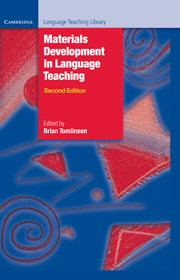Book contents
- Frontmatter
- Contents
- Preface
- Glossary of basic terms for materials development in language teaching
- Acknowledgements
- 1 Introduction: principles and procedures of materials development
- Part A Data collection and materials development
- 2 Using corpora in the language classroom
- 3 Concordances in the classroom without a computer: assembling and exploiting concordances of common words
- 4 Telling tails: grammar, the spoken language and materials development
- Comments on Part A
- Part B The process of materials writing
- 5 A framework for materials writing
- 6 Writing course materials for the world: a great compromise
- 7 How writers write: testimony from authors
- Comments on Part B
- Part C The process of materials evaluation
- 8 The analysis of language teaching materials: inside the Trojan Horse
- 9 Macro- and micro-evaluations of task-based teaching
- 10 What do teachers really want from coursebooks?
- 11 The process of evaluation: a publisher’s view
- Comments on Part C
- Part D The electronic delivery of materials
- 12 Developing language-learning materials with technology
- 13 New technologies to support language learning
- Comments on Part D
- Part E Ideas for materials development
- 14 Seeing what they mean: helping L2 readers to visualise
- 15 Squaring the circle – reconciling materials as constraint with materials as empowerment
- 16 Lozanov and the teaching text
- 17 Access-self materials
- Comments on Part E
- Conclusions
- Recommended reading
- Index
12 - Developing language-learning materials with technology
Published online by Cambridge University Press: 09 February 2023
- Frontmatter
- Contents
- Preface
- Glossary of basic terms for materials development in language teaching
- Acknowledgements
- 1 Introduction: principles and procedures of materials development
- Part A Data collection and materials development
- 2 Using corpora in the language classroom
- 3 Concordances in the classroom without a computer: assembling and exploiting concordances of common words
- 4 Telling tails: grammar, the spoken language and materials development
- Comments on Part A
- Part B The process of materials writing
- 5 A framework for materials writing
- 6 Writing course materials for the world: a great compromise
- 7 How writers write: testimony from authors
- Comments on Part B
- Part C The process of materials evaluation
- 8 The analysis of language teaching materials: inside the Trojan Horse
- 9 Macro- and micro-evaluations of task-based teaching
- 10 What do teachers really want from coursebooks?
- 11 The process of evaluation: a publisher’s view
- Comments on Part C
- Part D The electronic delivery of materials
- 12 Developing language-learning materials with technology
- 13 New technologies to support language learning
- Comments on Part D
- Part E Ideas for materials development
- 14 Seeing what they mean: helping L2 readers to visualise
- 15 Squaring the circle – reconciling materials as constraint with materials as empowerment
- 16 Lozanov and the teaching text
- 17 Access-self materials
- Comments on Part E
- Conclusions
- Recommended reading
- Index
Summary
Introduction
In this chapter I am going to explore ways of creating materials for language learning that make full use of the advantages of digital technologies. I will also take due account of our responsibilities as language teachers to develop multi-literacies, as argued by Warschauer and Healey as early as 1998 , and a common theme now both in the field of language learning and technology and of general education (Pegrum 2009). I will show how teachers can blend resources they would typically have in their classroom with the increasing range of technologies that are made available by publishers, and also with the large number of Web 2.0 technologies that can be found on the Internet. I will focus on discussing ideas that are achievable by many teachers. Towards the end, however, I will push the boundaries a little and present one or two technologies that may currently be available only to a very few of us.
Technology and language learning
In most classrooms the drivers of activity are the examination and a centralised curriculum, and as a result textbooks and teaching often refl ect this. In many parts of the world, for example, spoken language is not examined and so, although it might appear in the curriculum, it does not get taught. Teachers need, then, to be creative, if they want to give their learners a greater chance of being able to communicate. Teachers try to use technology to supplement language classes, because they believe there is very little time for real language use in typical language classes. Teachers are also conscious that learners do not always see why they are expected to study languages and they try their best to make the learning meaningful and real, to encourage their learners to engage. Many younger learners fail to understand why they are learning a language that appears to have little relevance to their daily lives; it is simply a part of the curriculum; it is on the timetable. This is something that a teacher can address by trying to help the learners make connections to the outside world where the language is being used for real tasks.
- Type
- Chapter
- Information
- Materials Development in Language Teaching , pp. 303 - 327Publisher: Cambridge University PressPrint publication year: 2011
- 7
- Cited by



